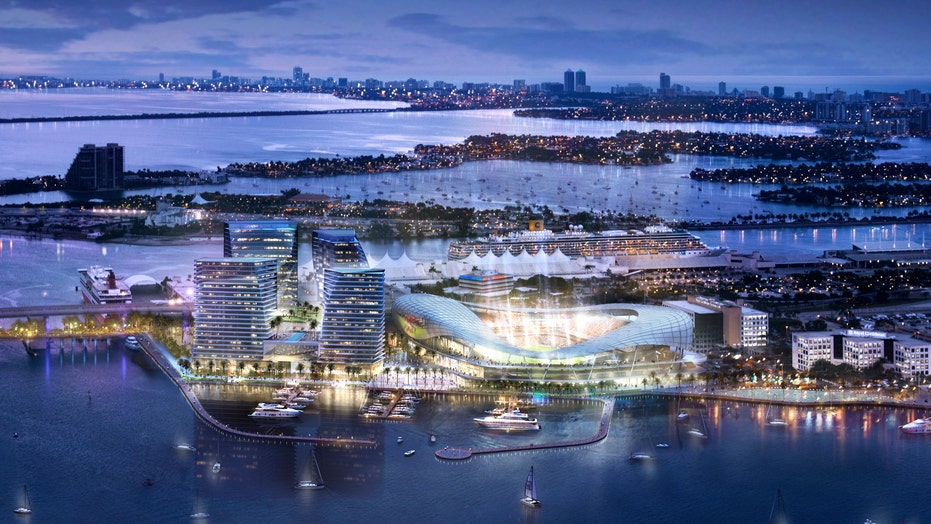Miami Beckham United — the ownership group headed by retired soccer star David Beckham that is establishing a Major League Soccer franchise in South Florida — unveiled plans this week to build a soccer stadium on a spit of land in the port area, across a footbridge from American Airlines Arena, where the Heat, the professional basketball team, plays.
The renderings, which show an open-air stadium next to a handful of prospective mixed-use buildings, make it clear that the project, despite initial opposition from Royal Caribbean Lines and other quarters, has a chance to transform the entire look of the port area and Bayside.
Which just makes Beckham a Johnny-come-lately compared to one of the architecture firms linked to the proposal.
“It’s hard to imagine what Miami would look like,” Beth Dunlop, a longtime architecture critic for the Miami Herald, told Fox News Latino, “without Arquitectonica.”
The Miami-based firm was founded in the late 1970s by a group of friends trained at Ivy League schools. Among them were the Peruvian immigrant, Bernardo Fort-Brescia, and his now wife, Laurinda Spears, as well as Elizabeth Plater-Zyberk and Cuban-Americans Andrés Duany and Hervin Romney.
Almost right away, they drew attention with their “Pink House” — a long, thin home on Biscayne Bay built for Spears’ parents — which used five different shades of pink. The colors were considered so garish back in 1977 that the community demanded that a line of palm trees screen the house from the street.
Eventually Miami have caught up to Arquitectonica’s color palette — not the last time the firm helped influence tastes.
By the mid-1980s, all the firm’s founders had left to start their own architecture and design shops, except for Fort-Brescia, now 62, and Spears. Together they would put the firm at the forefront of architecture with a series of condominiums: The Imperial, the Palace and especially, the Atlantis.
“So often condominium designers plop down these rectangular buildings, and don’t care about how the buildings meet the sky,” said Dunlop, editor-in-chief of Modern Magazine.. “Arquitectonica elevated the art of designing condos from the mundane to the far from mundane.”
One of the firm's founding members explained his philosophical approach to architectural design.
“Sometimes I think of a building as a person standing up,” Fort-Brescia told Fox News Latino, “with feet and a body and a head. Sometimes, of course, the building is horizontal and the person is lying down,” he added, laughing.
One condo, in particular, put the firm on the map through non-traditional means.
A distinctive building with a mirrored exterior that has a large, multistory cutout off center with a red spiral and a large palm tree tucked into it, the Atlantis was featured prominently in the title sequence of the once extremely popular TV show, “Miami Vice,” which debuted in 1984.
“That was something of a burden,” Fort-Brescia said. “The image of the city back then wasn’t as positive, and for a while it was a drag to have people bring that up. Today, it’s a total reversal: Miami is seen as this cool, modern, progressive place.”
Arquitectonica has a lot to do with that shift. From the curvaceous Miami City Ballet building to the steamship lines of the American Airlines Arena to the slender lines of the Wilkie D. Ferguson Jr. Federal Courthouse, the look of the city is deeply tied to the firm’s designs.
Asked if she could think of another city and architect so closely tied to each other, Dunlop said, “Not really. Maybe Oscar Niemeyer and Brasilia.” But, she adds, “Of course, Arquitectonica design buildings the world over.”
True. The firm now employs hundreds of architects and designers in New York, Los Angeles, Lima, Paris, Dubai, Hong Kong, Shanghai and Manila.
And Arquitectonica has expanded its portfolio in other ways: Spears has headed up the firm’s efforts in landscape architecture, interior and environmental design.
But there is a commonality to all their work: A sense of exuberance. A concern with surfaces. Interest in how constructions looks to a pedestrian, to a passenger in a car, to a bird.
As well as what Dunlop described as “a sense of derring-do. They like making buildings with elements that look like they’re impossible but aren’t.”
Not that Fort-Brescia sees it that way. “We never set out to create a signature style,” he said. “We look at every project as if we were starting all over again.”
Dunlop also pointed out that for most high-toned architects there used to be “a clean hands, pure heart attitude, while Arquitectonica were out there designing a discount mall.” She added, “Now Rem Koolhaus, Richard Meier, every major architect works on commercial condominiums. They revolutionized the discipline.”
For Fort-Brescia, working on the Beckham stadium design — which Arquitectonica executed with the Kansas City sports design firm, 360 Architecture — was a pleasure.
“I grew up in South America, so I’m a huge soccer fan,” he said. “It’s such a great pairing, David Beckham and Miami.”

